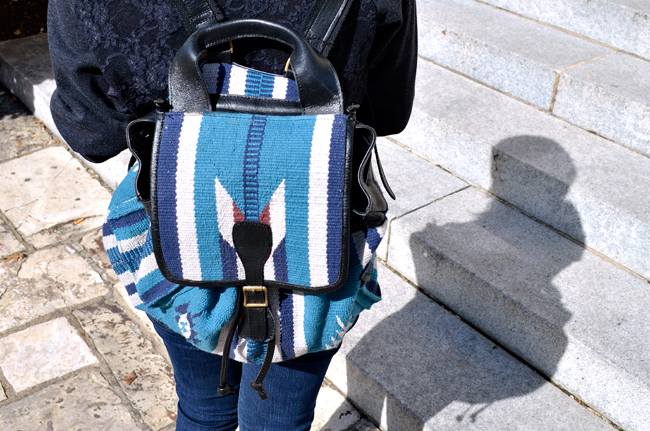While the recent popularity of Native American inspired fashion trends have some shoppers flocking to the clothes racks, others are concerned with stores’ usage of the term “Navajo” in descriptions of their products.
This winter season, stars like Megan Fox and Vanessa Hudgens were spotted cozying up in Navajo-inspired scarves and sporting colorful feather earrings. The pattern also made various designer runway appearances.
However, the current issue regarding the Navajo fashion trend has members of the community complaining that stamping the name “Navajo” onto colorful geometric prints and feathered accessories not handcrafted by the Navajo people themselves is a violation of trademark law and misrepresents southwest native cultures.
While this type of print has made its way into clothing chains like Macy’s and Forever 21, Urban Outfitters received most of the heat in part for two of the company’s items: the “Navajo hipster panty” and “Navajo print fabric wrapped flask.” Prior to the store’s removal of the label from its website, a search for the word “Navajo” retrieved a total of 23 items.
When interviewed, company spokesman Ed Looram said, “The Native American-inspired trend and specifically, the term ‘Navajo’ have been cycling through fashion, fine art and design for the last few years.” Yet both the Federal Trade Commission and the Federal Indian Arts and Crafts Act of 1990 “prohibit misrepresentation in marketing of Indian arts and crafts produced within the U.S.”
In response, members of the Navajo community signed a petition asking clothing companies to remove their name from stores and websites worldwide, also catching the attention of the Navajo Nation attorney general, who sent a cease and desist letter to Urban Outfitters, emphasizing that labeling items Navajo when they are not “undermines the character and uniqueness of the Nation’s long-standing distinctive Navajo name and trademarks.”
According to associate history professor Erika Bsumek, who specializes in Native American history, the main question is why Urban Outfitters chose to call those patterns “Navajo” in the first place when historically, the trend shows influences from various tribes, not just one.
“I think such products fell into a category that, a decade or two ago, would have been called ‘southwestern,” Bsumek said. “A key question is why Urban Outfitters called those patterns and products ‘Navajo’ in the first place — why didn’t they want to call them southwestern? Why did they think ‘Navajo’ as a label would have more appeal?”
With an Urban Outfitters located so close to campus, those who sport the Native American patterned backpacks and accessories have become of interest to the UT and Austin community.
While advertising senior Alissa Galindo, who has a quarter Native American heritage, loves to sport turquoise jewelry and admires that the Navajo trend is exposing shoppers to some elements of her culture, she feels sad that these generalized native patterns’ appearance on popular fashion might upset some of her ancestors.
“I wonder what my grandpa would think,” Galindo said. “He’d probably say, ‘we should be getting paid for this.’”
In Galindo’s view, while Native American print may capture the attention of shoppers, stores like Urban Outfitters are more interested with corporate profit than the artistic expressions of a specific people.
Rebecca Atkinson, a sophomore sign language student at Austin Community College, said that stores should go further in their measures to ensure authenticity in their designs.
“Stores should put up signs so the public can determine if the clothes are authentic or not,” said Atkinson, who is one-eighth Native American. Still, Atkinson said to a certain degree she thinks it’s good that people are being exposed to different cultural patterns.
Whether the Navajo trend is gaining popularity for all the wrong reasons, or is just another example of fashion experimenting with the old and the new, the trend has received attention from multiple disciplines outside of the fashion industry. Luckily, the issue has created a discourse about the use of native motifs in commercial fashion, allowing a deeper look into the contents of the display window.
Printed on Wednesday, February 1, 2012 as: Urban Outfitters sparks controversy with 'Navao' print















